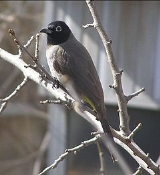
White-spectacled Bulbul
Encyclopedia
The White-spectacled Bulbul also known as the Yellow-vented Bulbul, Pycnonotus xanthopygos, is a small bird, a bit bigger than a sparrow
. It is 19–21 centimeters in length, and its wingspan is 20–25 centimeters. A stable bird that lives in fruit plantations, gardens, cities etc. It is the most common member of the Bulbul family in Israel and Lebanon. In Turkey, it is mainly found in the coastal Mediterranean region but its range extends from Patara/Gelemiş near Kaş in the west to Türkoğlu in the east.. Breeding populations are found from Central and Southern Turkey to Western Syria, The Lebanon, Western Jordan, Israel, Sinai and Western, Central and Southern Arabia.
Both sexes are similar; juveniles have a browner hood and less obvious eye-rings than the adults. The nest – a small cup of thin twigs, grass stems, leaves and moss – is generally located in bushes and lined with hair, shredded bark and small roots.
They can be considered as pets if raised by humans at an age not exceeding three weeks. When being raised, people usually feed them with bananas using a stick.
Sparrow
The sparrows are a family of small passerine birds, Passeridae. They are also known as true sparrows, or Old World sparrows, names also used for a genus of the family, Passer...
. It is 19–21 centimeters in length, and its wingspan is 20–25 centimeters. A stable bird that lives in fruit plantations, gardens, cities etc. It is the most common member of the Bulbul family in Israel and Lebanon. In Turkey, it is mainly found in the coastal Mediterranean region but its range extends from Patara/Gelemiş near Kaş in the west to Türkoğlu in the east.. Breeding populations are found from Central and Southern Turkey to Western Syria, The Lebanon, Western Jordan, Israel, Sinai and Western, Central and Southern Arabia.
Both sexes are similar; juveniles have a browner hood and less obvious eye-rings than the adults. The nest – a small cup of thin twigs, grass stems, leaves and moss – is generally located in bushes and lined with hair, shredded bark and small roots.
They can be considered as pets if raised by humans at an age not exceeding three weeks. When being raised, people usually feed them with bananas using a stick.

